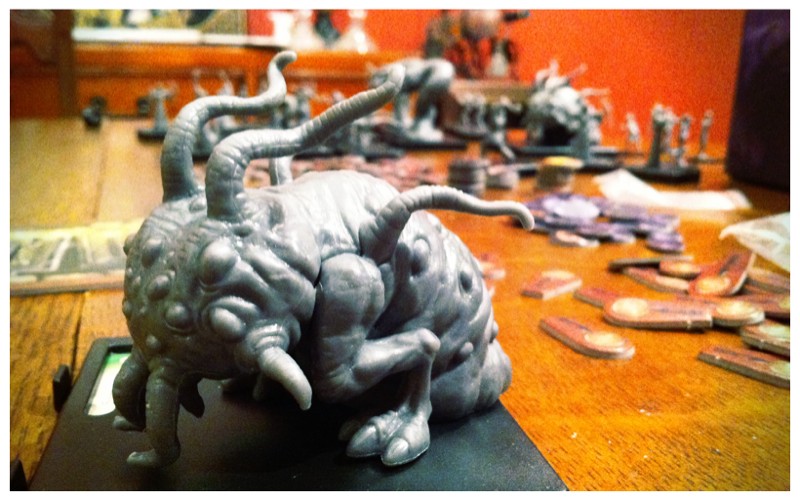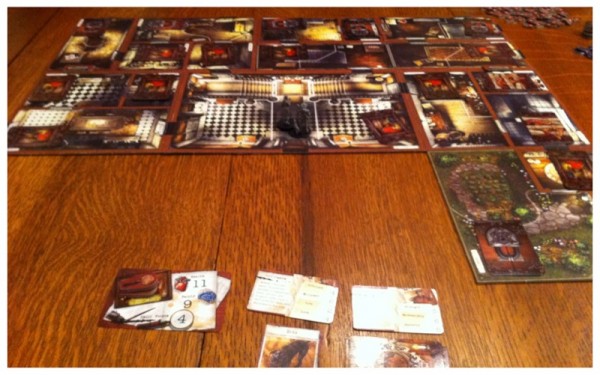
 What’s the sign of a good board game? Logical mechanics that make sense? Cooperative gameplay? The ability to ruthlessly kill your friends and have them hate you for the rest of your life? If you answered “Yes” to any of the above, then Mansions of Madness may very well be for you; it has all three, and executes them with aplomb.
What’s the sign of a good board game? Logical mechanics that make sense? Cooperative gameplay? The ability to ruthlessly kill your friends and have them hate you for the rest of your life? If you answered “Yes” to any of the above, then Mansions of Madness may very well be for you; it has all three, and executes them with aplomb.
Like Arkham Horror, Mansions of Madness is set in the Lovecraftian world/town/area of Arkham, Massachusetts. As luck would have it, strange and mysterious things are afoot that may or may not involve cults, evil ghost babies, and Cthulhians that come out of inter-dimensional portals to consume your soul. So it is up to you and your band of merry investigators to gather clues about what is happening using your wits and sometimes guns. Sometimes the answer really is just to use guns.
The game board is created from a set of smaller squares and rectangles that have varying rooms and hallways on them, and the layout is determined by which story the players choose at the beginning of the game. There are five overall stories, but each has multiple choices of story and item placement that the Keeper can choose (more on that in a second) as things are getting set up, allowing for a different story nearly every time the game is played. In one story, for example, the board pieces are arranged to form a “standard” mansion house, complete with a foyer and laboratory in addition to bedrooms and a kitchen. In another story, the setting is outside, so most of the board is grass and a cave. All told, there is probably about a baker’s dozen full of board pieces, each having two different sides for the various configurations.
Set up for this game is intense, and how the game is played can be likened somewhat to D&D. What you would otherwise call the Dungeon Master is here called the Keeper, and this person actively plays against the investigators as well as reads all the cards. During the set-up phase, the Keeper looks in the special Keeper rule book and determines the general flow of the game. For each story there are multiple questions the Keeper has to answer before gameplay starts, which will then determine where items are placed. The first few questions generally involve main story elements and the placement of clues for the investigators to find. So if you chose answer 1a for question 1, then clue 1a will be placed on a certain space on the board, and because clue 1a is where it is, the shotgun or lantern or tome, etc. will be in another space, and so on and so forth. The set-up honestly feels like it takes forever, but luckily while these decisions are made, the investigators are setting up the game board and choosing characters (which, by the way, are some of the same characters in Arkham Horror), so people aren’t wholly waiting around on one person.

Once the game is finally put together, the story can commence. There are quite a few fun story elements that come up via reading clue cards and investigating rooms, and if you don’t get into character while playing, then what’s the point? The general play goes something like this: The investigators can choose who goes first each time it’s the investigators’ turn, and they collaborate to figure out the best way to proceed. Nearly every space – once the Keeper finishes placing cards – will have something to investigate, and nearly all items are worthwhile, so the early game is generally spent collecting items and clues. At the start of the game, the investigators don’t actually know what their objective is. They have no idea how to win the game; it’s all based on the questions the Keeper answered, and he holds a card that says how to win for both the investigators and the Keeper. At a certain point during the game the objective is usually revealed, but until then, the investigators just attempt to figure out what needs to happen through context clues.
Then comes the Keeper’s turn, which is wholly separate from the investigators’. The Keeper, acting as the DM essentially, has to manage far more things than the investigators. Although it may not sound fun on paper to be the “bad guy,” once you put yourself in the mindset that the investigators are the bad guys, it makes it all the easier to hurt them and glean pleasure from it. At the start of the Keeper’s turn, he or she gains “threat” equal to the amount of investigators in play. That threat is used to play various Keeper cards that perform some action during their turn, whether it be to summon monsters, move monsters, or purchase one of another set of cards that can be used during the investigators’ turn. Once the Keeper has moved his minions and/or attacked investigators with them, he places one time token on yet another set of cards. There are generally just five or six of these other cards, and they correspond yet again to what story has been chosen. After a certain number of time tokens have been placed (say, five, for example), the card is flipped over and extra story information generally comes out in addition to new things for the investigators to deal with. Sometimes it’s simply harming the investigators as a whole, or reducing their sanity levels, and other times giant monsters are spawned. Suffice it to say that every five or so turns something drastic will happen, so watch out.
As just mentioned, investigators have both sanity and general health – almost exactly like Arkham Horror – to contend with. When a player enters a room with a monster, they have to roll a ten-sided die and complete a Horror Check to see if they are scared, and then fight the monster if they choose. If the investigator is horrified or damaged in their turn, the Keeper may play some of those nice cards they picked up in their last go that are specifically used during the investigators’ turn to wreak even more havoc. For example, there is a card called Kleptomania that can be played when an investigator loses sanity that forces them to steal one item from a friend if they happen to start their turn in the same space. There are dozens of these cards, and they are all aggravating if you are an investigator.
As you might expect, once either the investigators or the Keeper complete their objective, the game is over, and you and your friends can go about yelling at each other about how much you were a complete jerk as the Keeper. I have played the Keeper now twice, and in most normal games the general wankery that the Keeper gets to perform feels fairly congruent with how much power the investigators have to stop them. No one generally feels too over powered. There is one story, though, that might be pushing it far in favor of the Keeper. The story allows for the players to actively attack each other, and the Keeper gets the use of some special cards that he can give to investigators face down. Only that investigator can read the card, and its text can range from “This card does nothing” to “You are now on the side of the Keeper. If the Keeper wins, you win.” It really doesn’t matter what the cards say, necessarily, because they certainly arouse suspicion among the investigators. For the lucky person that gets the card that changes their loyalty, the investigators now have two people fighting against them, and it really becomes a little too much. My group of friends and I had serious stink faces towards each other after that game. No one really said goodbye afterwards, and we all just left in silence.
Mansions of Madness can currently be purchased for the low-low price of $56. I would certainly recommend it, even if it causes you to lose friends.